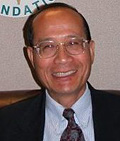Translational Research in Nano and Bio Mechanics
Additional materials available (5)
Licensed under General Performance Usage.
Category
Published on
Abstract
Bio
 Professor KEN P. CHONG, P.E. has been the Engineering Advisor and Director of Mechanics and Materials for the past 21 years at the National Science Foundation [NSF]. Currently he is associated with NIST and the George Washington University, writing a text book, editing a Elsevier and a Taylor & Francis journal, a Spon book series, doing lectures, serving on university advisory boards, etc. He earned his Ph.D. in Mechanics from Princeton University. He specializes in solid-mechanics/materials, nano-mechanics, and structural mechanics. At NSF in addition to managing 130 university research projects in mechanics/materials, he has been involved in the development of model-based simulation, durability and accelerated tests, life-cycle engineering, nano science and engineering, and other initiatives; and established the NSF Summer Institute on Nano Mechanics/Materials at Northwestern University. He was the Interim Division Director in 2005.
Professor KEN P. CHONG, P.E. has been the Engineering Advisor and Director of Mechanics and Materials for the past 21 years at the National Science Foundation [NSF]. Currently he is associated with NIST and the George Washington University, writing a text book, editing a Elsevier and a Taylor & Francis journal, a Spon book series, doing lectures, serving on university advisory boards, etc. He earned his Ph.D. in Mechanics from Princeton University. He specializes in solid-mechanics/materials, nano-mechanics, and structural mechanics. At NSF in addition to managing 130 university research projects in mechanics/materials, he has been involved in the development of model-based simulation, durability and accelerated tests, life-cycle engineering, nano science and engineering, and other initiatives; and established the NSF Summer Institute on Nano Mechanics/Materials at Northwestern University. He was the Interim Division Director in 2005.
Prior to joining NSF, he was a professor for 18 years during which he pioneered the R&D of architectural sandwich-panels; developed new semi-circular fracture specimens for brittle materials. His experimental research on sweet spots in the 70’s changed the design of tennis rackets. He has published 200 plus technical papers and authored several books including 2 textbooks on mechanics by Wiley, currently in 2nd and 3rd editions. In the 1980’s he was involved in the academic design of the new HKUST, now a top university. He has given more than 50 keynote lectures, received awards including the fellow of AAM, ASME, SEM, USACM and ASCE; Edmund Friedman Professional Recognition Award; Honorary Doctorate, Shanghai University; Distinguished Member, ASCE; NCKU Distinguished Alumnus Award; and the NSF highest Distinguished Service Award. He has been a visiting professor at MIT, U. of Washington – Seattle, U. of Houston; honorary professor at HKU, HK PolyU, Dalian U. of Technology and others.
Sponsored by
Cite this work
Researchers should cite this work as follows:
Time
Location
Armstrong 1109, Purdue University, West Lafayette, IN